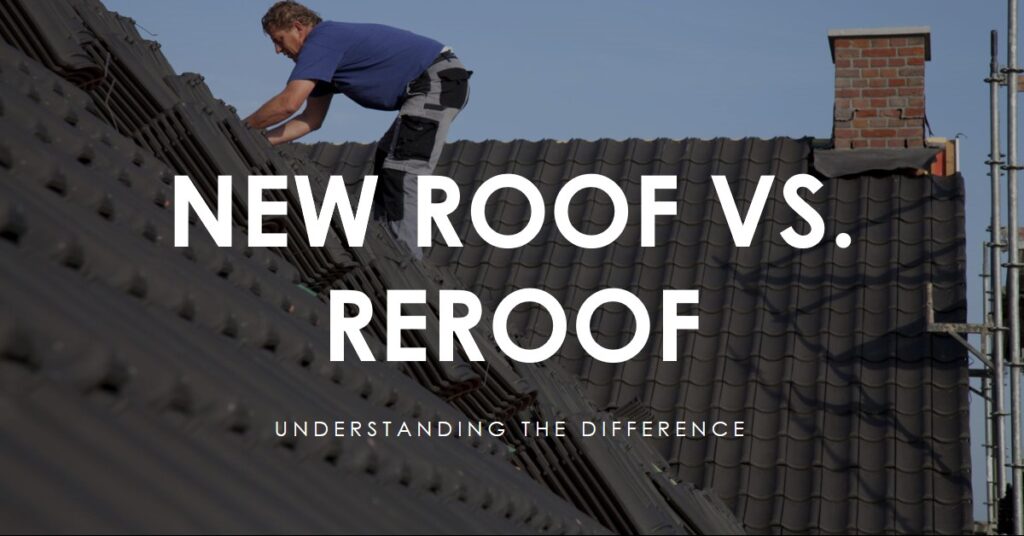Choosing between a new roof and reroofing can be complicated.
A new roof means the complete removal and replacement of your existing roofing system, and reroofing involves layering new shingles on top of the old ones.

Grasping this fundamental distinction will significantly influence your roofing decisions regarding costs and durability.
What Does a New Roof Entail?
Going for a new roof means a thorough process. All the old roofing materials, down to the foundational deck, are stripped away.
Once these are removed, professionals conduct a detailed inspection of the deck, rectifying any structural or water damage. Only then is a fresh set of roofing materials installed. It’s like resetting the clock on your roof’s lifespan.
Benefits of a New Roof
A completely new roof eliminates any legacy issues. With new materials from base to surface, homeowners can be assured of the maximum lifespan of these materials without the worry of latent damage.
It also offers the opportunity to choose updated, more efficient, or eco-friendly materials and to address any insulation or ventilation issues.
Drawbacks and Considerations
The comprehensive nature of a new roof installation means it will inevitably be more expensive. This is due to the thorough labor involved and the cost of new materials.
The process can also be disruptive, often necessitating homeowners to vacate the property temporarily or make provisions for noise and work crews.
What is Reroofing?
In essence, reroofing is a cosmetic update. It involves placing a fresh layer of shingles atop the existing ones.
This method does away with the need for tearing off old materials, which means fewer labor hours and less mess.
When is Reroofing Suitable?
Reroofing is generally suitable for roofs in decent condition without significant structural issues. If the existing roof is relatively new but has minor damages, reroofing can be an economical choice.
However, roofs that have already been reroofed once may need better candidates due to weight considerations.
Pros and Cons of Reroofing
The primary advantages of re-roofing include cost and time savings. However, while reroofing might address surface issues, it doesn’t allow for inspecting underlying structures.
There’s a risk that existing problems, like leaks or wood rot, could worsen over time.
Key Factors to Consider When Deciding On a New Roof or Reroofing
Roof’s Age and Condition
The age and health of your current roof are crucial determinants. Young roofs with cosmetic damages benefit from reroofing, while older roofs or those with multiple issues might necessitate a full replacement for long-term peace of mind.
Cost Implications
While reroofing might seem less expensive upfront, it’s crucial to consider potential long-term costs, especially if underlying issues go undetected.
A new roof, although more expensive initially, can offer more extended warranty and longevity.
Regional Climate and Weather Patterns
The local climate can play a significant role. For instance, homes in areas prone to storms, hurricanes, or heavy snowfall might require the thoroughness of a new roof installation to ensure maximum protection and durability.
Seek Professional Advice
Every home is unique, and generic advice might only sometimes be applicable. A seasoned roofing professional can provide guidance tailored to your home’s specifics and budgetary constraints.
Common Recommendations from Roofing Professionals
Roofing professionals usually prioritize the structure’s safety and longevity. Depending on factors like age, current state, and homeowner preferences, they suggest either a reroofing job or a complete overhaul.
The former is for less severe issues, and the latter is for older roofs or roofs with structural problems.
Making the Best Choice for Your Home
Roofing decisions significantly influence your home’s safety, aesthetics, and energy efficiency. Whether opting for a new roof or reroofing, the focus should be long-term value, security, and peace of mind.
By thoroughly weighing the advantages and disadvantages, coupled with professional advice, homeowners can make informed decisions that serve them well for years.
